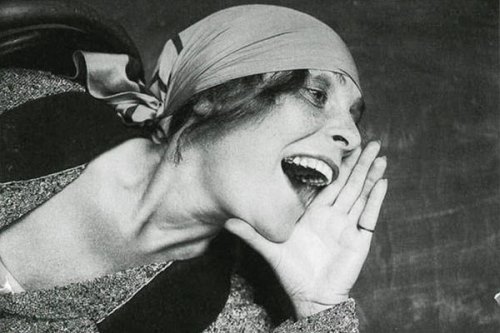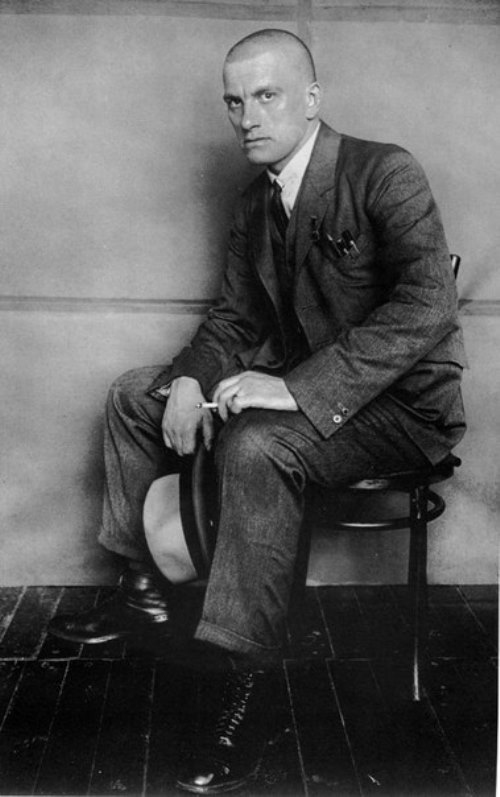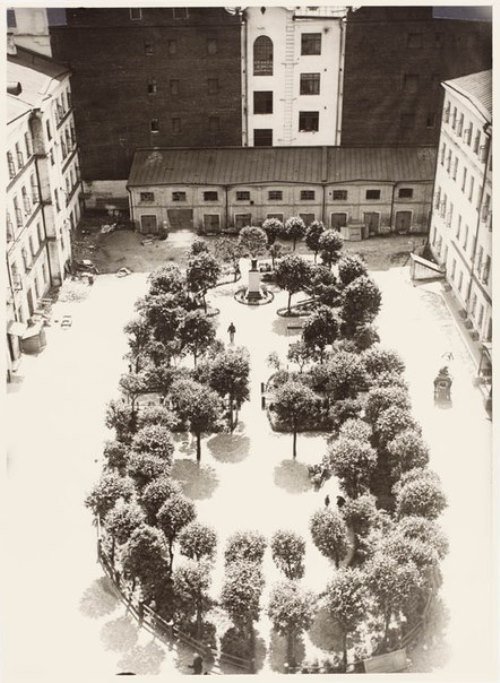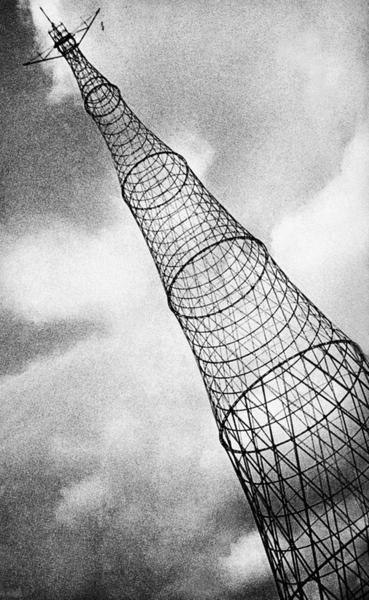Soviet photographer Alexander Rodchenko
Most photos his photos Soviet photographer Alexander Rodchenko created in the late 20’s – 30’s of the last century. At that time he was mainly worked in magazine photo. Together with Varvara Stepanova, he creates one of the first thematic photo albums on the history of the USSR. In particular, the Red Army, and the socioeconomic development of the Central Asian republics of the USSR. At the same time, the Soviet photographic art reached its peak. And it was no accident. Photographers were able to depict the unprecedented in its scale industrialization processes to depict a grand process of the socialist transformation of the country and society. In the editorial column of the first famous magazine “USSR in Construction”, with which Rodchenko constantly collaborated as a photographer and designer, photograph was proclaimed one of the main types of Soviet art, displaying socialist construction in the dynamics.
Alexander Rodchenko and Varvara Stepanova met in 1913 at the Kazan Art School. After graduating and passing military service in the army medical unit Rodchenko, the son of laundress and theater worker, remained in St. Petersburg cold basement without any possibilities of existence and with a great desire to work.
In 1917, immediately after the February Revolution in Moscow was created the trade union of painters. Rodchenko became secretary of its young Federation engaged primarily in the organization of normal living and working conditions for young artists, most of whom welcomed the October Revolution. “We praise aloud revolution as the only engine of life” – declared Rodchenko and Stepanova. It was the time of analysis the reality around them, the beginning of a new understanding of the revolutionary processes taking place in society and the laws of their causes, the definition of future goals. And this understanding for each started with awareness of their own position.
In the first years of the Revolution, Rodchenko and Stepanova, together with Wassily Kandinsky, Malevich, Tatlin, El Lissitzky, Alex Hahn entered the Moscow group of suprematists and abstractionists proclaiming obsolete any concrete art forms. During this period, they are experimenting with color and composition of the works, and in 1918 announced the transition to non-objectivity as a new stage in the development of art. However, in parallel Rodchenko created technical models, called “spatial constructions”, they are the first sketches and models of new buildings.
Since 1923, they are active employees of “LEF”, the magazine of the Left Front of Arts, overseen by Mayakovsky. By publishing it in his theoretical materials, Rodchenko at the same time develops the first collages for registration of the magazine, which then became a model of constructivist design. Working on them, he decides to emphasize the problem of the most important graphic details for maximum strength of ideological influence of the artistic image – in collages of Rodchenko, in the words of a contemporary, “it is the view of ideology.” At the same time, they were created by the static and dynamic titles for Dziga Vertov’s newsreels, the first innovator of Soviet documentaries. (Later, in 1925 it was he who issued the movie posters of “Battleship Potemkin” by Sergei Eisenstein, bypassed with the picture of the capitalist world). In turn, Stepanova, together with L. Popova made mobile theater installation, which for a long time determined the “face” of the theater of Vsevolod Meyerhold.
Then, in 1923, Rodchenko, together with Mayakovsky begins work on a series of famous Mosselprom advertising. In total they have made more than 100 sketches – “verses”, more precisely, the couplets by Mayakovsky, of which about sixty went into general circulation. Advertised were the most diverse products – essential goods, garments, household, cigarettes, confectionery. A characteristic feature of advertising design of Rodchenko was weaving in its composition and graphic concepts iconic elements, such as arrows, pointers, emphasizing imagery couplets of Mayakovsky. The popularity of this new Soviet advertising was huge, it immediately replaced the previously dominant “NEP art” (NEP – The New Economic Policy). “We fully conquered Moscow and completely shifted, or rather, changed their old tsarists-bourgeois-Western style of advertising on the new Soviet” – later recalled with pride Rodchenko.
At least the high score of this work was obtained, and at the International Exhibition of Decorative Arts and the art industry, held in 1925 in Paris, Rodchenko received for it the silver medal in the “street art”. At the end of the exhibition, Rodchenko executed the famous Soviet design of the exhibition catalog.
In the same 1925, in Paris, with Rodchenko wished to meet Picasso, Leger, with their great interest to the development of Soviet art. According to witnesses, this meeting did not take place mostly just because of language difficulties, as well as because closed by nature Rodchenko felt uncomfortable abroad. He admitted to Stepanova that only once he felt comfortable in Paris, when he saw in the subway a group of workers singing the “Internationale”: “That’s when I first realized that I was not alone in Paris.” However, it is the Paris exhibition has become a discovery of the new Soviet art, where was first recognized its world-wide significance.
It is known that Rodchenko and Mayakovsky were interested in the technology of the organization of festive demonstrations, the mechanism of their implementation. They tried to “theoretically” construct a rally, a processing to achieve maximum effect from the event.
Soviet photographer Alexander Rodchenko worked in the theater as well. In 1929 Rodchenko creates the stage design of the play by A. Glebov “Inga”, staged in the Theater of the Revolution. Using the modern theme of the play about the life of a young woman – a garment factory director, Rodchenko and Stepanova develop fine detail of home, office, club furniture and clothing.
Alexander Rodchenko began photographing in 1924, and a year later began his first – in Soviet Russia – experiments with perspective and points shooting. He, as an artist, does not satisfy with the standard horizontal composition and a straight angle, the former “unbroken tradition” for photographers of that time. Another has done an extremely important step in the most fundamental change of photo subjects. In the early twenties he often portrayed static “sculptures”, “manufactured in artistic poses”. Rodchenko saw what photography can – and therefore should be the only true art, as accurately reflecting the life – in the moments that make up its movement. For this purpose it was necessary to shoot the life of the young Soviet republic, developing, being built around, here and there, showing it from a variety of angles, allowing, in his view, to “catch” and reveal the content of the subject, or even a social phenomenon.
Meanwhile, in 1929 the critics tried to blame Rodchenko in the imitation of Western photographers, but in the published “New Lef” article he, in a simple manner – dates the chronology of creation of his work, he has denied all suspicions of borrowing from “bourgeois photographers”. In 1933, as a correspondent for the magazine, he spent the whole year at the construction of “White Sea Canal”, where he created a series of two thousand images. At the same time El Lissitzky and his wife create a photo series of “USSR in Construction”, dedicated to the Dnieper Hydroelectric Station. In the future, the magazine continues to publish about this or that construction in the form of “epic photo story”.
In fact, it is these ideas of Rodchenko – again, undeclared, but simply expressed themselves in innovative images. They quickly gained huge popularity among young photographers and created in Soviet photography whole direction of press photographers. Besides, had the great impact on the youth division of the army of “worker correspondents.” And from this school came the best Soviet photographers of the 30’s – Arkady Shaikhet, Boris Ignatovich, and Mark Alpert.
Finally, at the end of the twenties, appeared association of “Left” photographers – a group of “October” and Rodchenko became one of its leaders.
Soviet photographer Alexander Rodchenko

Four Muses of Soviet art (from left to right – Shostakovitch, Mayakovsky, Meyerhold, Rodchenko) at the rehearsal of ‘Bug’, 1929











































